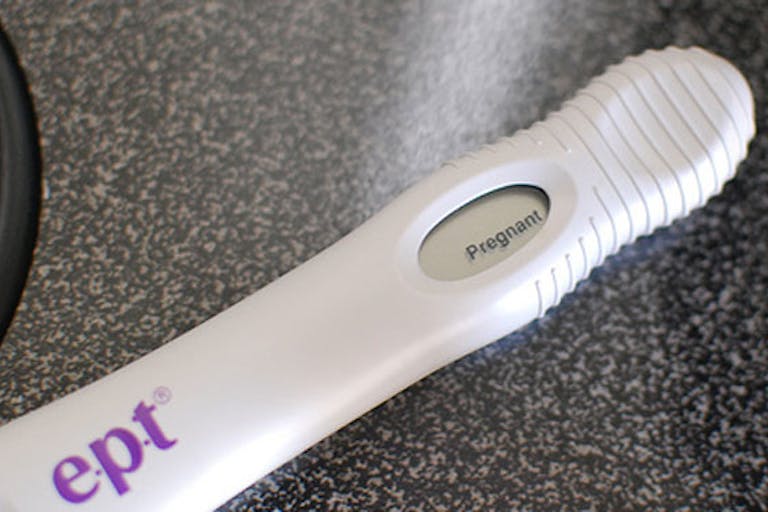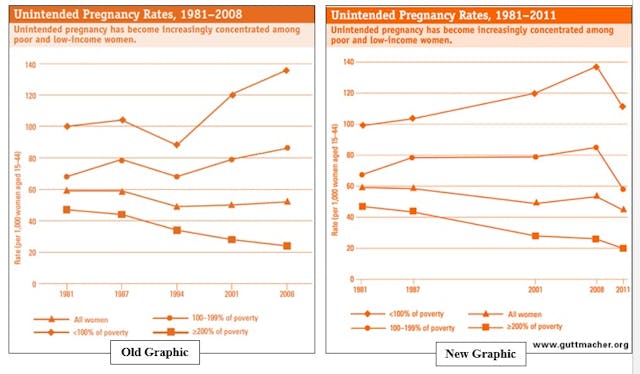Still factual errors in his piece, including that @Gutmacher is PP’s “research arm.” We’re fully independent guttmacher.org/about/history

Guttmacher’s defense of deleted pregnancy data falls short
Guttmacher’s defense of deleted pregnancy data falls short
Last week, we highlighted Willis Krumholz’s Federalist article detailing how the pro-abortion Guttmacher Institute appears to have dropped a 1994 data point from its materials on unintended pregnancy rates to obscure Planned Parenthood’s role in driving them up in the mid-1990s and falsely suggest its promotion of intrauterine devices was key to driving them back down.

Guttmacher spokesman Joerg Dreweke replied, claiming the data point was flawed, and removed to more accurately reflect the true rates. Now, Krumholz has answered the charge, defending his work and maintaining that Guttmacher still has some explaining to do.
While conceding the explanation deserved a mention in his original piece, Krumholz first notes an obvious reason why Dreweke’s cries of victimization are overblown:
I had no intention to forgo Guttmacher’s side of the story, having given Guttmacher public relations employees nearly two weeks, full of repeated phone calls, to comment prior to the release of the article. They failed to do so.
Indeed. If the matter really was as simple as that, there’s no reason Guttmacher wouldn’t have offered it to one of several media inquiries from the start, thereby preventing unnecessary bad press.
Why didn’t they? Perhaps because they’re exaggerating the significance of their defense. The data point was allegedly omitted because Center for Disease Control statisticians were concerned about the source survey—the 1995 National Survey of Family Growth—suffering from a programming error that caused “a smaller-than-expected percentage of respondents to receive one of the questions leading to the question that captures whether the pregnancy was unwanted.”
However, Krumholz goes on to detail how other NSFG surveys contain outliers too, yet “Guttmacher has begun to choose which surveys to use and which to ignore, which just happens to reinforce Planned Parenthood’s policy goals.” He also explains that the CDC’s unwanted births number is the sum of births it classifies as “unintended’ (the category impacted by the faulty data) plus those classified as “mistimed” (which wasn’t affected)—and the numbers still show the decline even when that is taken into account:
Article continues below
Dear Reader,
In 2026, Live Action is heading straight where the battle is fiercest: college campuses.
We have a bold initiative to establish 100 Live Action campus chapters within the next year, and your partnership will make it a success!
Your support today will help train and equip young leaders, bring Live Action’s educational content into academic environments, host on-campus events and debates, and empower students to challenge the pro-abortion status quo with truth and compassion.
Invest in pro-life grassroots outreach and cultural formation with your DOUBLED year-end gift!
Between the 1988 and 1995 NSFGs, unwanted births dropped 2 percentage points, from 12.4 percent, to 10.2 percent, respectively. Mistimed births, unaffected by any error, dropped from 26.7 percent in 1988 to 20.5 percent in 1995. In other words, of the almost 9 percent decline in unintended births from 1988 to 1995, from 39.1 percent to 30.6 percent, only a relatively small part of that drop was subject to any survey error.
At most, then, Guttmacher can claim the decline shouldn’t have been as sharp as the old graph made it look—not that the decline didn’t happen at all. It should “still show a drop in the unintended rate among poor women in 1994, and a subsequent large increase in 2001.”
Krumholz maintains that his original thesis still stands:
The accurate telling of history is that between the late 1980s and 1994, the unintended pregnancy rate among poor women was going down, or was at worse unchanged. Even if it didn’t go down from 1987 to 1994, it was lower than it is today. This occurred in a time when IUD use was limited, and PPFA received less taxpayer funding. Then, suddenly, there was a big jump from 1994 to 2001, just as PPFA got bigger.
The media stories should be “unintended pregnancy rates for poor women finally dropping to where they were in the ‘90s, before things got really bad in 2001,” and “more competition needed among providers of healthcare for poor women,” not “unintended pregnancies are finally dropping because our liberal policies are working.”
Krumholz’s full follow-up at the Federalist is definitely worth your time—it elaborates on all of the above, shows how Guttmacher’s work props up a false narrative justifying ever-increasing federal tax dollars for Planned Parenthood, and offers some valuable thoughts on how pro-lifers should respond.
Finally, Dreweke is still complaining about the rebuttal on Twitter, and Krumholz is tackling his objections point-by-point. Those are worth checking out, but one in particular deserves mention here:
“Fully independent”? Carole Noveilli raised major doubts about that last month at Live Action News. Guttmacher was considered a “special affiliate” of Planned Parenthood Federation of America for thirty years after the two supposedly separated, was listed by Planned Parenthood as an “independent affiliate” in its tax filings as recently as 2007, and that both organizations have donated millions of dollars to one another from 2001 to 2007.
Their potential material bonds remain suspicious enough, and their ideological bonds as abortion defenders are self-evident—and considering that deceit is a perennial staple of the pro-abortion cause, all of Guttmacher’s output should be read with what they’re not telling us in mind.
Live Action News is pro-life news and commentary from a pro-life perspective.
Contact editor@liveaction.org for questions, corrections, or if you are seeking permission to reprint any Live Action News content.
Guest Articles: To submit a guest article to Live Action News, email editor@liveaction.org with an attached Word document of 800-1000 words. Please also attach any photos relevant to your submission if applicable. If your submission is accepted for publication, you will be notified within three weeks. Guest articles are not compensated (see our Open License Agreement). Thank you for your interest in Live Action News!
Read Next

Vietnamese Catholics widen support for pregnant mothers
Angeline Tan
·More In Analysis

Analysis
Abortion supporter harasses peaceful pro-life activist in viral video
Cassy Cooke
·
Analysis
Man convicted of trafficking stolen body parts sentenced to six years in prison
Cassy Cooke
·
Analysis
Healthy woman died by assisted suicide in Oregon after faking doctor and diagnosis
Cassy Cooke
·
Analysis
College professor arrested for murder of pregnant mistress who refused abortion
Cassy Cooke
·
Analysis
Is picking the 'best' embryo a mere parenting tool, or eugenics fueled by hubris?
Nancy Flanders
·More From Calvin Freiburger

Guest Column
Report finds false advertising among Pennsylvania Planned Parenthood centers
Calvin Freiburger
·
Abortion Pill Reversal
Tennessee prosecutor refuses to enforce law to inform women of abortion pill reversal
Calvin Freiburger
·
Guest Column
Stillbirths on the rise amid COVID-19 lockdowns around the world
Calvin Freiburger
·
Abortion Pill Reversal
Abortion groups sue over Tennessee law requiring abortion pill patients to receive information on reversal
Calvin Freiburger
·
Activism
Pro-life senator holds minute of silence on senate floor for dismemberment abortion victims
Calvin Freiburger
·